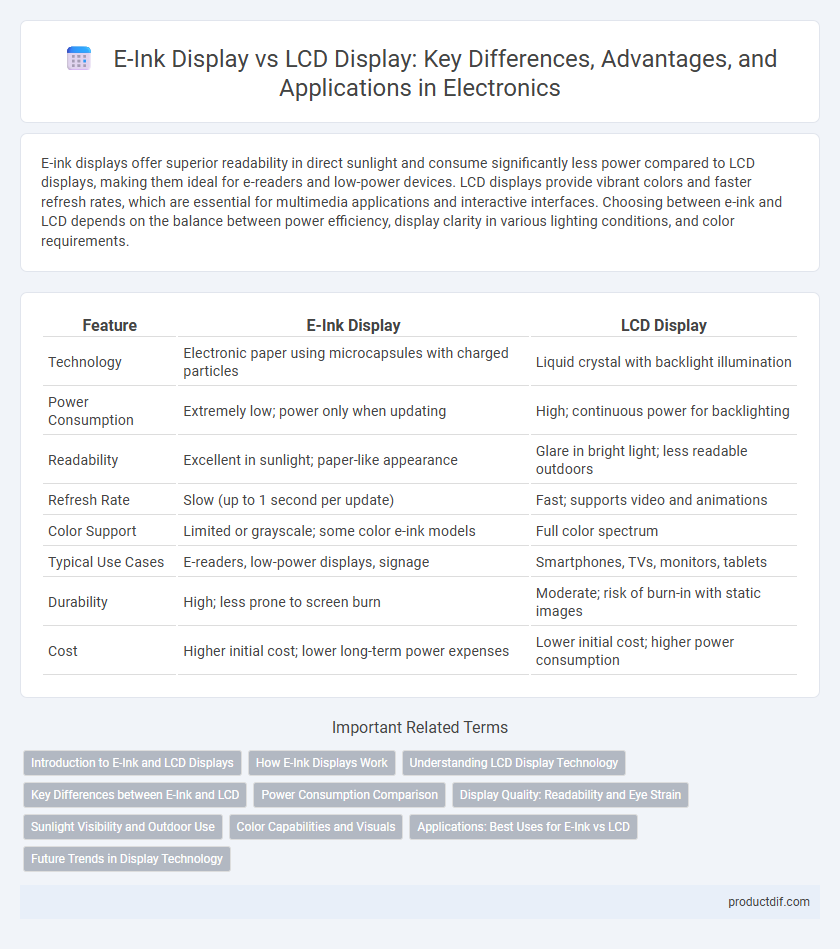E-ink displays offer superior readability in direct sunlight and consume significantly less power compared to LCD displays, making them ideal for e-readers and low-power devices. LCD displays provide vibrant colors and faster refresh rates, which are essential for multimedia applications and interactive interfaces. Choosing between e-ink and LCD depends on the balance between power efficiency, display clarity in various lighting conditions, and color requirements.
Table of Comparison
| Feature | E-Ink Display | LCD Display |
|---|---|---|
| Technology | Electronic paper using microcapsules with charged particles | Liquid crystal with backlight illumination |
| Power Consumption | Extremely low; power only when updating | High; continuous power for backlighting |
| Readability | Excellent in sunlight; paper-like appearance | Glare in bright light; less readable outdoors |
| Refresh Rate | Slow (up to 1 second per update) | Fast; supports video and animations |
| Color Support | Limited or grayscale; some color e-ink models | Full color spectrum |
| Typical Use Cases | E-readers, low-power displays, signage | Smartphones, TVs, monitors, tablets |
| Durability | High; less prone to screen burn | Moderate; risk of burn-in with static images |
| Cost | Higher initial cost; lower long-term power expenses | Lower initial cost; higher power consumption |
Introduction to E-Ink and LCD Displays
E-ink displays utilize microcapsules containing charged black and white particles that rearrange to form images, offering low power consumption and excellent readability in bright light. LCD displays employ liquid crystals manipulated by electric fields to control backlight passage, resulting in vibrant colors and fast refresh rates suitable for dynamic content. Understanding these fundamental technologies highlights the key differences in power efficiency, visibility, and usage scenarios between e-ink and LCD screens.
How E-Ink Displays Work
E-ink displays operate using microcapsules filled with positively charged white particles and negatively charged black particles suspended in a clear fluid; when an electric field is applied, these particles move to the surface to form images. This technology mimics the appearance of ink on paper, providing high contrast and excellent readability in bright sunlight while consuming minimal power since energy is only used when the image changes. Unlike LCD displays that use backlighting and liquid crystals to produce images, e-ink screens rely on reflected ambient light, making them ideal for low-power devices like e-readers.
Understanding LCD Display Technology
LCD display technology utilizes liquid crystals that modulate light to produce images by controlling the alignment of molecules between two polarizing filters, enabling precise control of color and brightness. Unlike e-ink displays, which rely on electrophoretic movement of particles to reflect ambient light, LCDs require a backlight source to illuminate the screen, resulting in higher power consumption but brighter and more vibrant visuals. This technology supports fast refresh rates and high-resolution graphics, making it suitable for devices like smartphones, monitors, and televisions where dynamic content is essential.
Key Differences between E-Ink and LCD
E-ink displays use electrophoretic technology to manipulate charged pigment particles, providing paper-like readability with minimal power consumption, ideal for e-readers and outdoor use. LCD displays rely on backlit liquid crystals to produce vibrant colors and fast refresh rates, making them suitable for multimedia applications and devices requiring dynamic content. The key differences include power efficiency, with e-ink significantly outperforming LCD, and display performance, where LCD excels in color reproduction and responsiveness.
Power Consumption Comparison
E-ink displays consume significantly less power than LCD displays because they only use energy when updating the screen, allowing for extended battery life in devices like e-readers. LCD screens require continuous backlighting, leading to higher energy consumption even when displaying static images. This difference makes e-ink technology ideal for low-power applications, whereas LCDs suit devices needing vibrant color and fast refresh rates.
Display Quality: Readability and Eye Strain
E-ink displays provide superior readability in bright sunlight due to their reflective nature, mimicking paper and reducing glare, which significantly minimizes eye strain during extended reading sessions. In contrast, LCD displays emit light directly and often create glare, leading to increased eye fatigue, especially in low-light environments. The bi-stable nature of e-ink technology also means no continuous power is needed to maintain the image, enhancing comfort for prolonged use compared to traditional LCD backlighting.
Sunlight Visibility and Outdoor Use
E-ink displays offer superior sunlight visibility compared to LCD displays due to their reflective technology, which mimics paper and reduces glare under direct sunlight. LCD screens rely on backlighting, causing washed-out visuals and increased power consumption in bright outdoor environments. E-ink's low power usage and excellent readability make it ideal for prolonged outdoor use, while LCDs perform better in controlled indoor lighting conditions.
Color Capabilities and Visuals
E-ink displays offer limited color capabilities, typically supporting up to 16 grayscale shades or a few basic colors, resulting in muted and less vibrant visuals ideal for reading and low-power applications. In contrast, LCD displays provide a broad color spectrum with millions of colors, delivering sharp, bright, and vivid visuals suitable for multimedia and dynamic content. The difference in color reproduction and brightness directly influences the choice between e-ink for energy-efficient, readable screens and LCDs for rich, colorful displays.
Applications: Best Uses for E-Ink vs LCD
E-ink displays excel in applications requiring low power consumption and high readability in direct sunlight, such as e-readers, smartwatches, and electronic shelf labels. LCD displays are preferred for devices demanding vibrant color reproduction and fast refresh rates, including smartphones, tablets, and monitors. E-ink's bistable nature makes it ideal for static content and long battery life, while LCDs suit dynamic multimedia and interactive interfaces.
Future Trends in Display Technology
E-ink displays are advancing with improved refresh rates and color capabilities, positioning them as energy-efficient alternatives for e-readers and low-power devices. LCD technology is evolving through mini-LED and micro-LED integrations, offering enhanced brightness, contrast, and longer lifespans for smartphones and televisions. Future display trends emphasize hybrid solutions combining e-ink's energy efficiency with LCD's vibrant color performance to meet diverse consumer demands.
e-ink Display vs LCD Display Infographic

 productdif.com
productdif.com